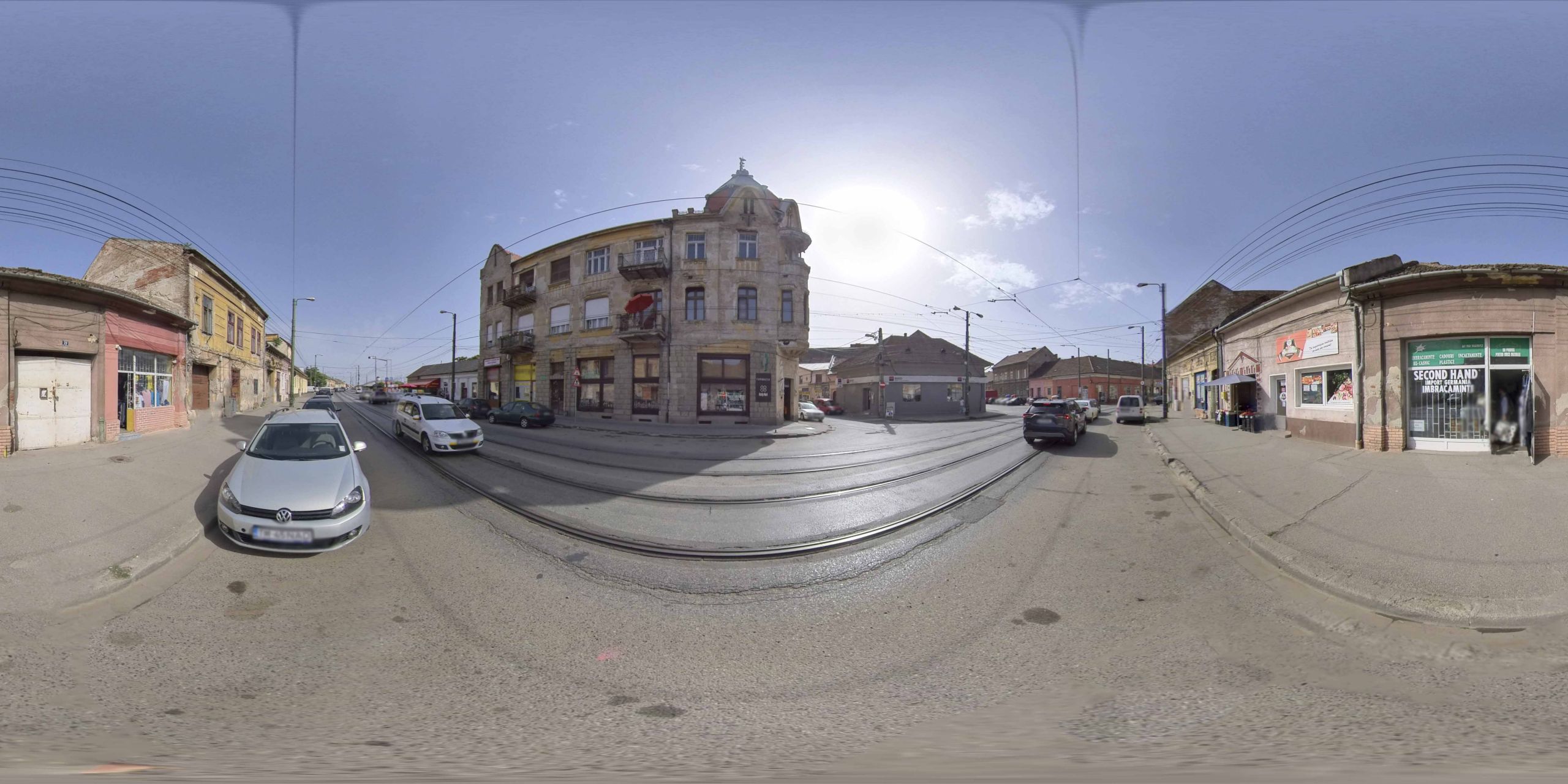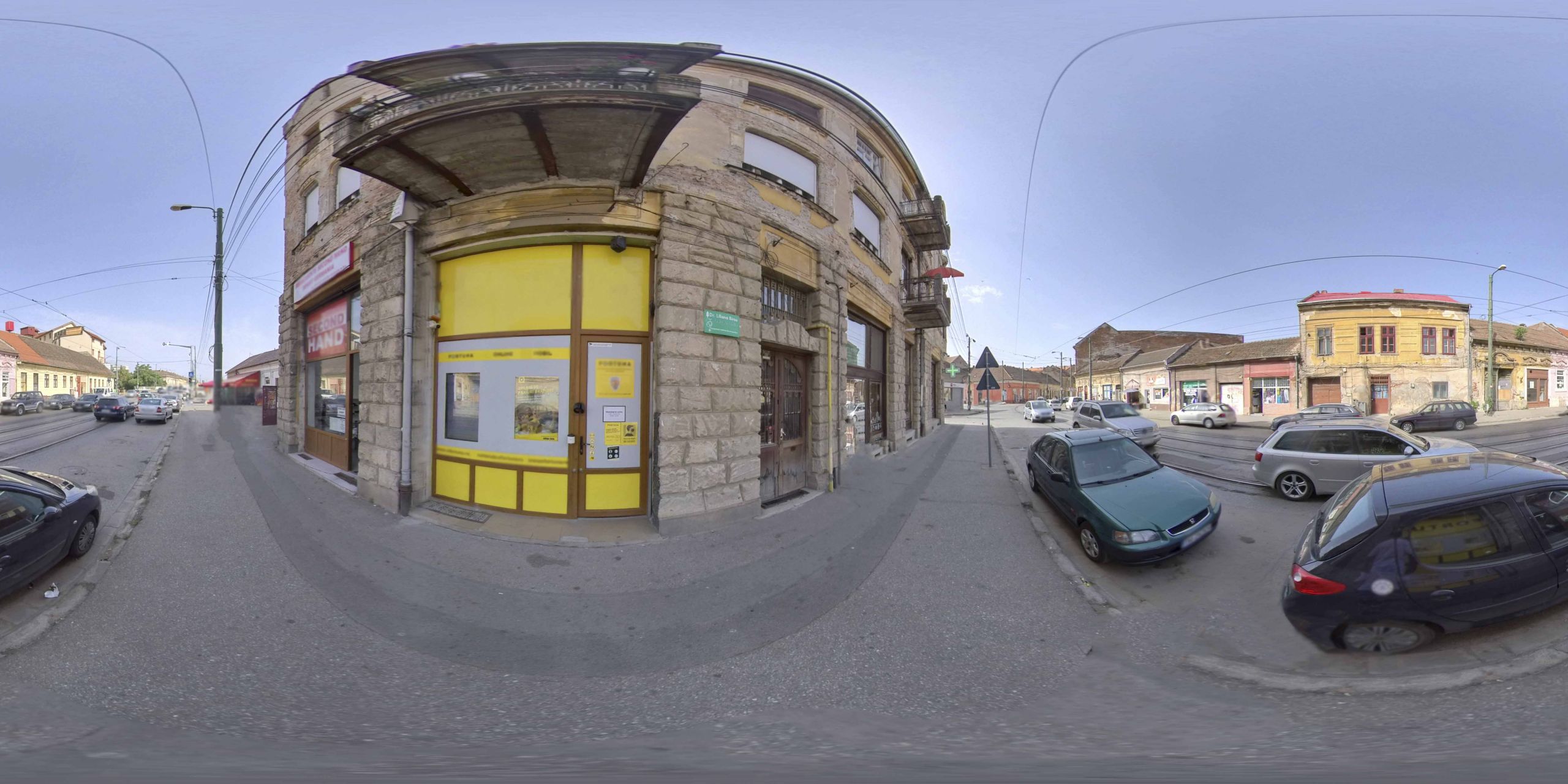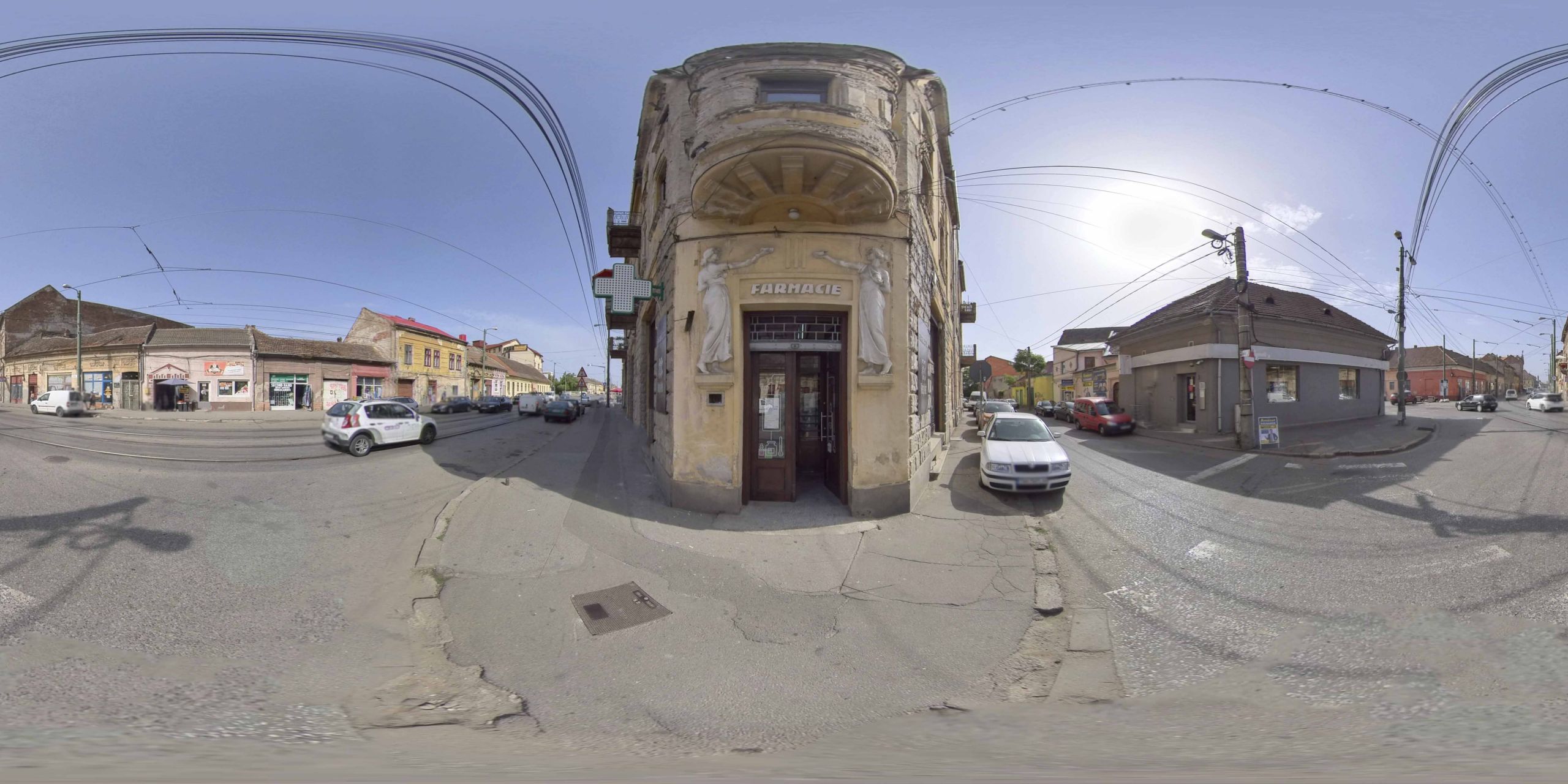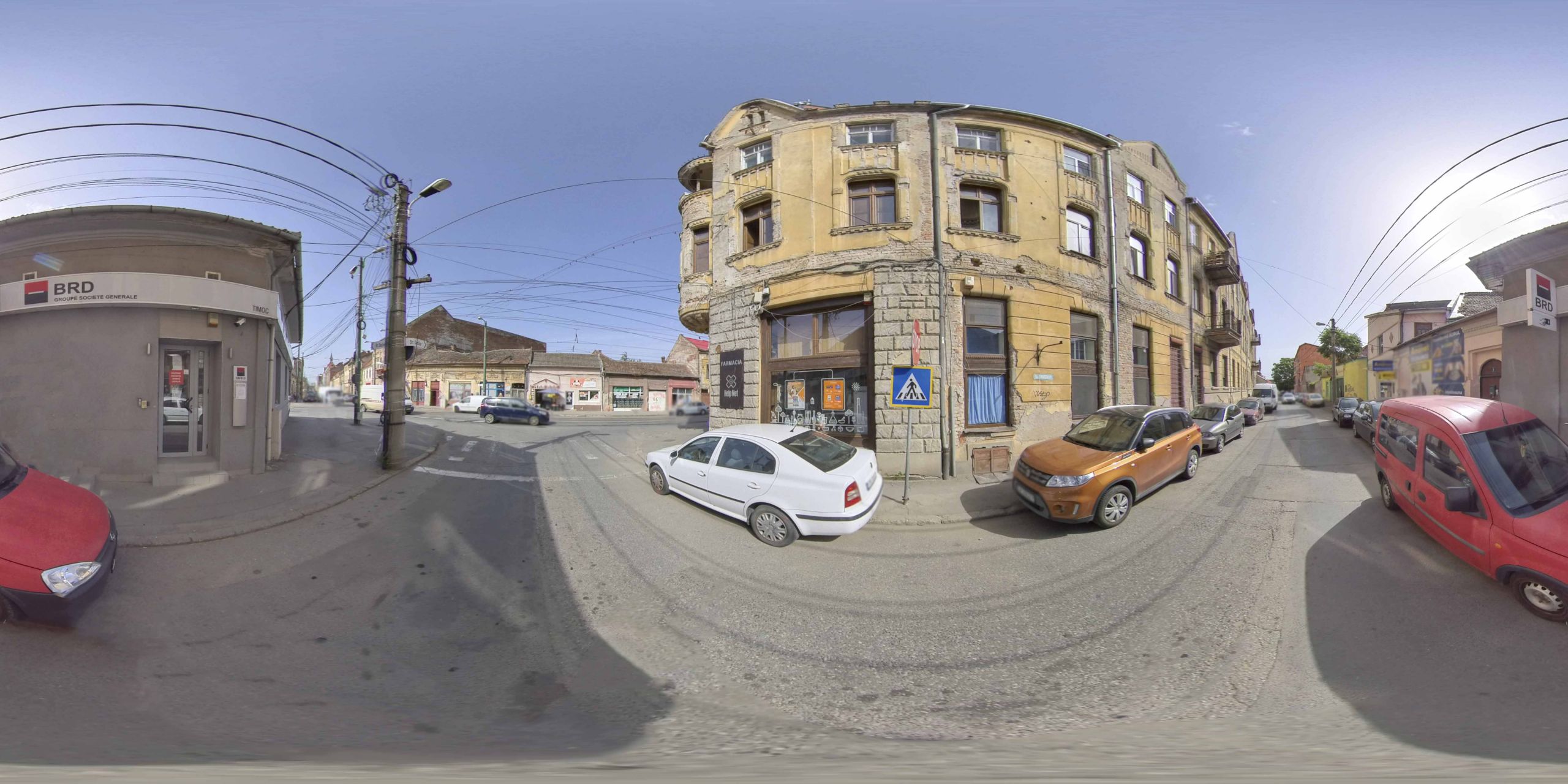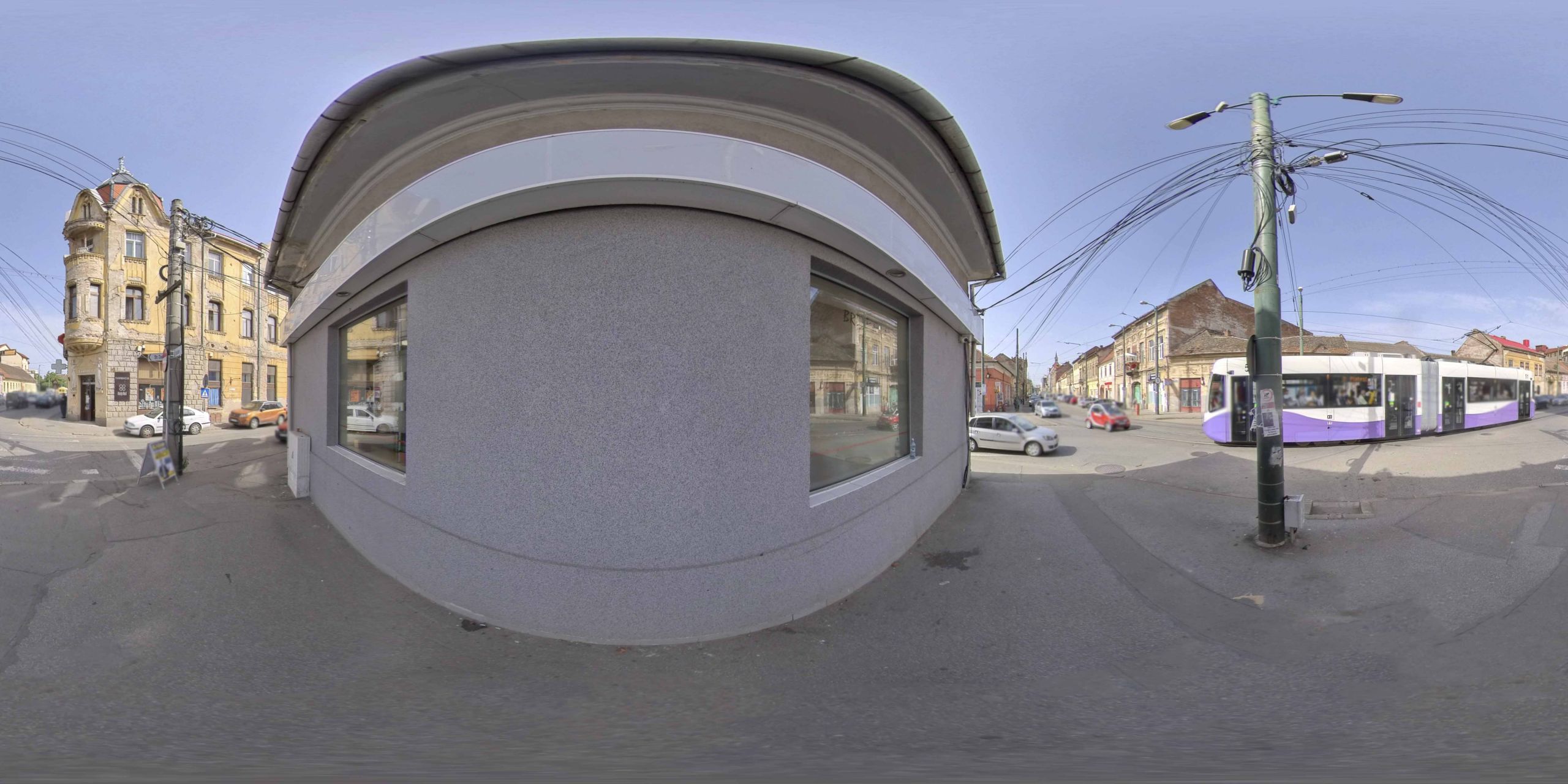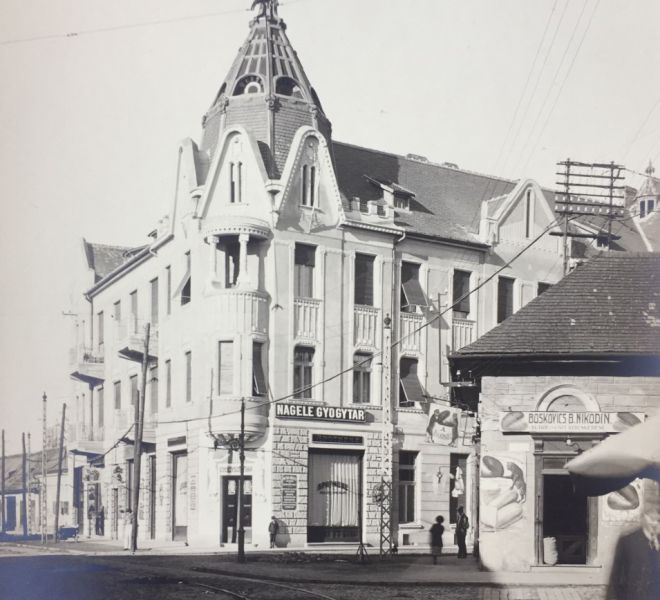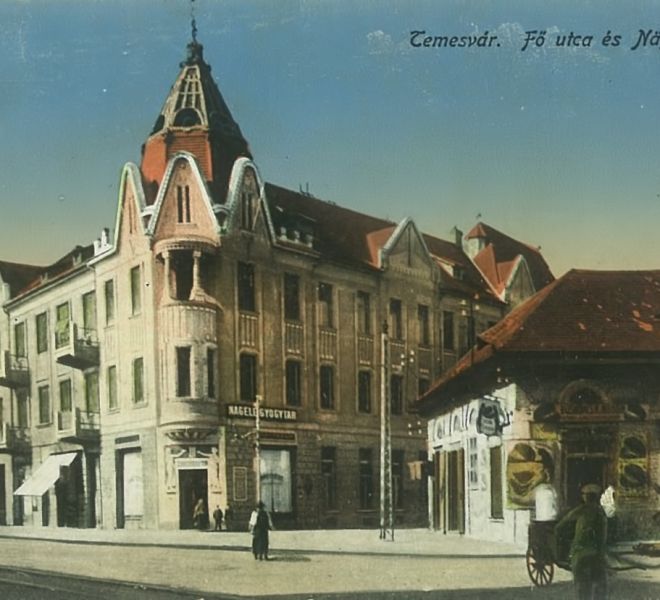The Kovács Pharmacy
Architect Henrik Telkes designed a two-story Secession-style building, on the ground floor of which is the pharmacy popularly known as Kovacs Pharmacy.
Listen to the audio version.
In 1873 the pharmacy The Holy Trinity (“Zur Heiligen Dreifaltigkeit”) was established at the corner of Dacilor and Timocului streets. The pharmacy changed its owner several times, becoming in 1898 the property of Anton Nägele. At his request, architect Henrik Telkes designed a two-story Secession-style building. The symbol of Asclepius is still enthroned on the top of the tower, at the corner of the building, on the ground floor of which is the pharmacy commonly known as the Kovacs Pharmacy. This name is explained by the fact that in 1917 both the building and the pharmacy on its ground floor became the property of pharmacist Dr. Aladár Kovacs.
To the east of Dacilor Street, in an area between Petru Rareș Square, Ecaterina Teodoroiu Street, Ion Creangă Street and Timocului Street, a significant Jewish community operated, until the middle of the last century, which had both places of worship and other institutions that were necessary for a traditional community life, such as a bath and a ritual slaughterhouse or a Talmud Torah school. On the streets of this area there were several tailoring and leather processing workshops, as well as various shops, which completed the image of this miniature “ștetl” of the Fabric neighborhood.
Bibliography:
Getta Neumann, On the trail of Jewish Timisoara. More than a guideBrumar Publishing House, Timisoara, 2019.
The Kovács Pharmacy
From Traian Square towards Bega (Dacilor Street, Hay Market/Piața de fân): Schönbrunn clothes shop, Musafia clothes shop, Müller photographer, Deutsch ironworks warehouse. Opposite of the Singer string shop / corner with Petru Rareș Square, then Adler glass
On Dacilor Street, corner with Timocului Street, Kovács pharmacy. In Timocului Street, the Schlosser leather factory, then across the bridge on the riverbank Beghei, the wool industry, owned by Totisz. On the other side, the Splaiul Peneș Curcanul street - Rosenthal and Telkes soap factory; Färber varnish and paint factory - Fadepa factory (also with Jewish directors) and Pollák sock factory.
In the Hay Market towards the train station, Left drinks; Kohn grocery; Spitzer wood depot; Reisch, all wood; opposite of the train station the summer restaurant Pacizerta (Ciacarta), Jewish owners - Havas. Opposite, the Standard socks factory (Roherlich).
Annie Hammer, born Kincs, in 1920 in Timișoara - excerpt from Jewish Destinies in Timișoaraby Getta Neumann, Hasefer Publishing House, Bucharest, 2014.
My father was of the Sephardic religion and in the Sephardic community, the one who said the prayers wasn’t called rabbi, but hazan. In Timișoara my parents opened a small shop. My mother and father both worked in the shop. My mother also did tailoring and they both were very busy. What I remember is that I grew up in a courtyard with many neighbours, with children in the courtyard who all spoke Hungarian. And in order to tell my parents better what I wanted, I would tell my brother in Hungarian to tell my mother this and that and he would translate it into Romanian. I had a brother three years older who died at the age of thirteen.
Rolla László, born in 1926 in Craiova - excerpt from the interview conducted by Antonia Komlosi in Timișoara in 2003, The oral history and anthropology group archive, coordinated by Smaranda Vultur.
(...) And I tell you that the Orthodox lived in Fabric too, not only in Iosefin. Even today the Synagogue in Iosefin is an Orthodox synagogue, it's not a neolog, we are neolog, the Citadel and Fabric, but Orthodox Jews lived in Fabric. Ecaterina Teodoroiu Street still bears this name, Tandlery. Do you know what that Tandleryis? Junk, junk street/ flea market. Because you could find all the old furniture there. You needed something, a wardrobe, you were going there. Tandlerei, junk street/ flea market. Nowadays it's called ..... it's where the Serbian Church is just to the left. Perpendicular to the church. What's it called? Ecaterina Teodoroiu street is the other one. That's where the Spanish church used to be. The Orthodox Church from Fabric was in the Ion Creangă, with their rabbis and their specific community. But this street, sir?! We are in Traian Square, here is the Serbian Church and you turn left. Not Anton Pann, not to the brewery, the other way round. That was the Jewish Street itself. There was Tandlerei. In Ecaterina Teodoroiu Street there is a place where the hederwas, the primary Jewish school where religion was taught, also called heider or heder. This is a purely Jewish school for religious initiation. The connection between Trajan Square and Ecaterina Teodoroiu was Tandlerei, there was also the furrier Kohn, the Jews were there. This neighbourhood is Jewish. And Ion Creangă, where the church (synagogue) is. Even today, in the churchyard, there is the mitzvah, there is the bath. And today it still exists, it is the ritual bath. Well, you couldn't set foot in the synagogue, you couldn't bathe the first time. With steam, with water. It's there in the courtyard. The remains are made of concrete. Men's program finishes, at three, at four it’s done, ready, cleaned and then women and girls come in. Clean. There's no such thing. Those are the laws of Moses. We don't have any, we haven't had any. No, but the Orthodox... ah..., those are religious, sir. They supported these people.
Oscar Schwartz, born in 1910, Vienna - excerpt from the interview conducted by Adrian Onică in 2001 in Timișoara, published in Memoria salvată,, The Jews of Banat yesterday and today, coordinated by Smaranda Vultur, Polirom Publishing House, Iași, 2002.
The Turkish court
On the street that used to be called Ulița Jidovească, now called 1 Mai, lived moneylenders and antique dealers. They were all Jews, many of them were Gallicans, and they wore those little hair-braces and black plush hats. Many merchants borrowed money from these moneylenders who came here to this inn called the Turkish Court. The name Turkish Court is inappropriate because Turks did not come here, but Christian merchants from Wallachia, Serbia, which was under the Turks, and from Bulgaria, which was also under the Turks. In the basement were the warehouses. It probably existed around the beginning of the last century, around 1825-1830. Only the style is copied from the Turkish buildings in Lipova where you will see arched corridors. (...)
George Vaida, born in 1926 - excerpt from the interview conducted by Smaranda Vultur in Timișoara in 1998, The oral history and anthropology group archive, coordinated by Smaranda Vultur.
From Traian Square towards Bega (Dacilor Street, Hay Market/Piața de fân): Schönbrunn clothes shop, Musafia clothes shop, Müller photographer, Deutsch ironworks warehouse. Opposite of the Singer string shop / corner with Petru Rareș Square, then Adler glass
On Dacilor Street, corner with Timocului Street, Kovács pharmacy. In Timocului Street, the Schlosser leather factory, then across the bridge on the riverbank Beghei, the wool industry, owned by Totisz. On the other side, the Splaiul Peneș Curcanul street - Rosenthal and Telkes soap factory; Färber varnish and paint factory - Fadepa factory (also with Jewish directors) and Pollák sock factory.
In the Hay Market towards the train station, Left drinks; Kohn grocery; Spitzer wood depot; Reisch, all wood; opposite of the train station the summer restaurant Pacizerta (Ciacarta), Jewish owners - Havas. Opposite, the Standard socks factory (Roherlich).
Annie Hammer, born Kincs, in 1920 in Timișoara - excerpt from Jewish Destinies in Timișoaraby Getta Neumann, Hasefer Publishing House, Bucharest, 2014.
My father was of the Sephardic religion and in the Sephardic community, the one who said the prayers wasn’t called rabbi, but hazan. In Timișoara my parents opened a small shop. My mother and father both worked in the shop. My mother also did tailoring and they both were very busy. What I remember is that I grew up in a courtyard with many neighbours, with children in the courtyard who all spoke Hungarian. And in order to tell my parents better what I wanted, I would tell my brother in Hungarian to tell my mother this and that and he would translate it into Romanian. I had a brother three years older who died at the age of thirteen.
Rolla László, born in 1926 in Craiova - excerpt from the interview conducted by Antonia Komlosi in Timișoara in 2003, The oral history and anthropology group archive, coordinated by Smaranda Vultur.
There was Tandlery. In Ecaterina Teodoroiu Street there is a place where Hederwas, the primary Jewish school where religion was taught, also called Heider or Heder. This is a purely Jewish school for religious initiation. The connection between Trajan Square and Ecaterina Teodoroiu was Tandlerei, there was also the furrier Kohn, the Jews were there. This neighbourhood is Jewish. And Ion Creangă, where the church (synagogue) is. Even today, in the churchyard, there is the mitzvah, there is the bath. And today it still exists, it is the ritual bath. Well, you couldn't set foot in the synagogue, you couldn't bathe the first time. With steam, with water. It's there in the courtyard. The remains are made of concrete. Men's program finishes, at three, at four it’s done, ready, cleaned and then women and girls come in. Clean. There's no such thing. Those are the laws of Moses. We don't have any, we haven't had any. No, but the Orthodox... ah..., those are religious, sir. They supported these people.
Oscar Schwartz, born in 1910, Vienna - excerpt from the interview conducted by Adrian Onica in 2001 in Timişoara published in Memoria salvată,, The Jews of Banat yesterday and today, coordinated by Smaranda Vultur, Polirom Publishing House, Iași, 2002.
